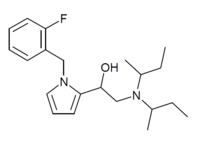Contents
Viminol (marketed under the brandname Dividol) is an opioid analgesic developed by a team at the drug company Zambon in the 1960s.[1] Viminol is based on the α-pyrryl-2-aminoethanol structure, unlike any other class of opioids.[2][3]
Viminol has both antitussive (cough suppressing) and analgesic (pain reducing) effects. Viminol has additional effects similar to other opioids including sedation and euphoria.[citation needed] It has six different stereoisomers which have varying properties. Four are inactive, but the 1S-(R,R)-disecbutyl isomer is a μ-opioid full agonist around 5.5 times more potent than morphine and the 1S-(S,S)-disecbutyl isomer is an antagonist.[4][5] Since viminol is supplied as a racemic mixture of isomers, the overall effect is a mixed agonist–antagonist profile similar to that of opioids such as pentazocine, although with somewhat fewer side effects.[6]
Side effects
Side effects are similar to other opioids, and can include:[medical citation needed]
- Itching
- Nausea
- Sedation
- Respiratory depression - can be potentially life-threatening
However, since viminol is supplied as a racemic mixture of agonist and antagonist isomers, the abuse potential and respiratory depression tends to be less than that of μ-opioid full agonist drugs.[medical citation needed]
Drug dependence may occur.[7]
Related compounds
Later work showed that replacing the chlorine atom with an fluorine atom (2F-Viminol) or with a trifluoromethyl group produced a compound with twice the potency and half the acute toxicity.[8] A later team at Zambon found that one isomer of a pyrrolidone analog is 318 times as potent as morphine in its analgesic activity in animal studies.[9] A number of related compounds were also found to be active, allowing a QSAR model to be constructed.
References
- ^ US 3539589, Teotino UM, Bella DD, "1-(α-Pyrryl)-2-amino Ethanols", issued 10 November 1970, assigned to Whitefin Holding SA
- ^ Contri AM (April 1981). "[Chromatographic separation of diastereoisomers of aminoalcohol salts and their densitometric determination]". Il Farmaco; Edizione Pratica (in Italian). 36 (4): 215–22. PMID 6894429.
- ^ Neto JM, Murad JE, Monteiro SS (December 1977). "Psychopharmacological properties of the viminol-p-hydroxybenzoate". Revista Brasileira de Pesquisas Medicas e Biologicas. 10 (6): 361–8. PMID 609773.
- ^ US 3857857, Della D, Bella CV, Monza DC, Tiotino UM, "Stereoisomers of 1(1'(-O-Chlorobenzyl)-2'-Pyrryl)-2-Disec.Butylamino-Ethanol", issued 31 December 1974, assigned to Whitefin Holding SA
- ^ Shook JE, Kallman MJ, Dewey WL (January 1984). "The discriminative stimulus properties of the R2 isomer of viminol". Pharmacology, Biochemistry, and Behavior. 20 (1): 59–62. doi:10.1016/0091-3057(84)90101-1. PMID 6546450. S2CID 11418389.
- ^ Cinelli M, Costa V, Ventresca GP, Lodola E (May 1986). "Viminol R2 analgesic activity in patients with postoperative pain: comparison with pentazocine". International Journal of Clinical Pharmacology, Therapy, and Toxicology. 24 (5): 232–5. PMID 3525423.
- ^ Turkiewicz G, Baltieri DA (2009). "Dependence on Viminol". Journal of Substance Use. 12 (4): 301–305. doi:10.1080/14659890701237124. S2CID 71184621.
- ^ US 4148907, Conti F, "Stereoisomers of 1-(1'benzyl-2'pyrryl)-2-di-sec.-butylaminoethanol and pharmaceutical compositions comprising same", issued 10 April 1979, assigned to Etablissement Viridis
- ^ US 4960788, Carenzi A, Chiarino D, Bella DD, Grancini GC, Veneziani C, "Pyrrolidone-2 compounds and their use for central analgesic activity", issued 2 October 1990, assigned to Zambon Group S.P.A.
- ^ Napoletano M, Fraire C, Grancini G, Mosotto C, Ricciardi S, Zambon C, et al. (1995). "Stereoselective synthesis and evaluation of all stereoisomers of Z4349, a novel and selective μ-opioid analgesic". Bioorganic & Medicinal Chemistry Letters. 6 (5): 589–592. doi:10.1016/0960-894X(95)00077-7.




